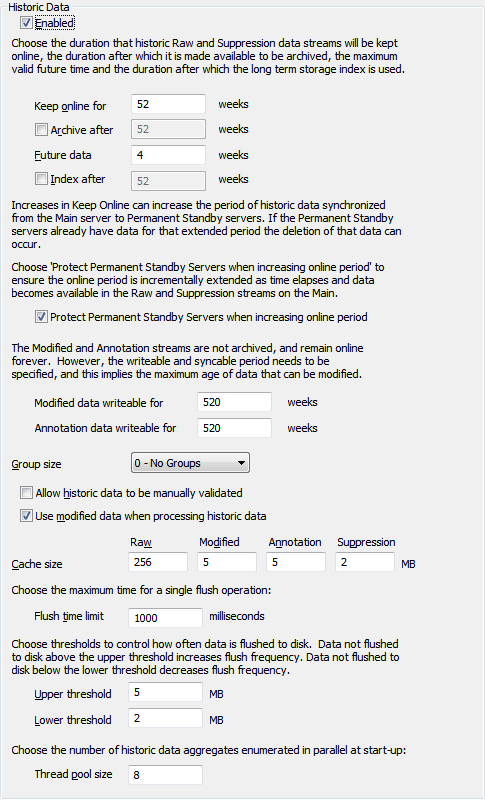The Historic Data settings apply to the historic data for database items that support historic data storage (database points, master station accumulators and some driver-specific items). This differs from event data and configuration changes data (see Historic and Archive Data). When enabled, the Historic Data feature creates historic files, with each historic file containing 1 week's worth of historic data for an individual item.
Do not confuse the Historic Data settings with the Historic Files setting. The Historic Files setting allows you to enable or disable historic storage of reports and documents, for example, file upload reports and Crystal Reports reports (see Enable or Disable Historic Files).
The Historic Data settings are located in the Historic Configuration branch of the Server Configuration Tool:

You can use the Historic Data settings to:
- Enable or Disable Historic Data Storage - The Historic Data feature allows data to be stored in the database as historic data that can be searched and accessed. The historic data is useful for comparing values over periods of time and observing patterns in the data.
- Specify the Duration to Retain Historic Data Online - ClearSCADAallows you to specify the duration that Alarm Summary, Configuration Changes Auditing, Event Journal or Historic Data., is retained online. Each data type can have a different duration. When this period of time expires, the historic data is deleted from the disk to allow space for the latest messages or data.
- Define the Archive Time for Historic Data - When Alarm Summary, Configuration Changes Auditing, Event Journal or Historic Data. is stored online for a specified duration it can easily be retrieved. Once the period has expired, the data is deleted. You can mark data to be archived after a period of time to allow archiving of the data to other forms of media such as CDs, DVDs or data storage tapes.
- Specify the Future Data Time for Historic Data - Historic data records that have a time stamp with a date and time in the future can be stored historically. Typically, records with future dates and times relate to forecasted data or data from a device that has different time settings, such as an outstation that has not had its clock set correctly.
- Manage the Size of the Primary Index - The Primary index allows your system to retrieve historic data quickly. However, if you store large amounts of data online the index can impact on the performance of your server. You can manage the size of the index to ensure your system performs efficiently.
- Protect the Permanent Standby Servers - ClearSCADA allows you protect the data on your Permanent Standby servers if you need to increase the Keep online for setting to increase the period of historic data synchronized from the Main server to Permanent Standby servers.
- Define the Historic Group Size to Optimize Performance - Groups are an optional set of folders, which divide the item into manageable group sub-folders. The Group Size setting defines the maximum number of <Items> sub-folders permitted for each group folder.
- Enable or Disable Manual Historic Data Validation - Historic data can be marked as 'unvalidated' until it has been checked and validated by a user. By examining the historic values, users can check that the reported values are accurate before marking them as valid.
- Define whether Modified Data is Used when Processing Historic Data - When ClearSCADA processes historic data, it performs calculations on the raw values to create the engineering values. You can also include the modified values so that the engineering values are the results of calculations on both the raw values and the modified values.
- Define the Historic Data Cache Size - When users on ClearSCADA clients perform searches on historic data (Alarm Summary, Configuration Changes, Event Journal or Historic data), the section of data that is required for the search is loaded from disk into the cache on the ClearSCADA server. On many systems, the default settings for the Cache Size, are appropriate and do not need to be altered. However, if memory usage is causing performance issues on your system, you may want to adjust the cache size.
- Configuring the Cache Flush Time and Threshold Limits - You can define the Flush Time Limit, Upper Threshold and Lower Threshold features to limit the amount of cache memory that can be used to contain historic data files—this reduces the possibility of the server running out of memory when users are performing searches on historic data.
- Define the Thread Pool Size - When a ClearSCADA server starts, it has to initialize the Alarm Summary, Historic Data, Event Journal, and Configuration Changes stored for your system. Larger systems are more likely to benefit from a higher number of threads. This is because large systems take longer to start and often have better hardware than smaller systems. By increasing the Thread Pool Size on a large system, it is possible to improve startup time, in some cases quite significantly.
Further Information